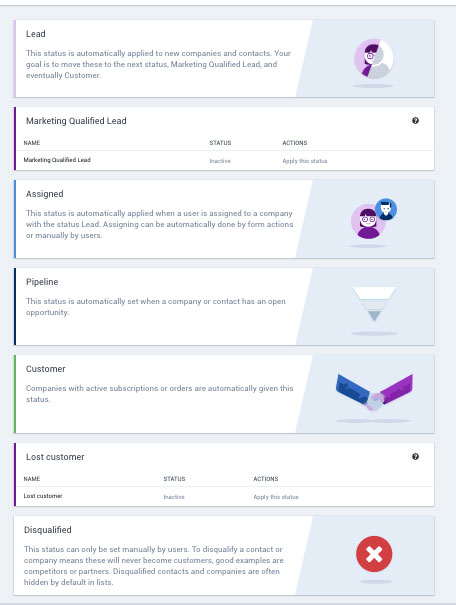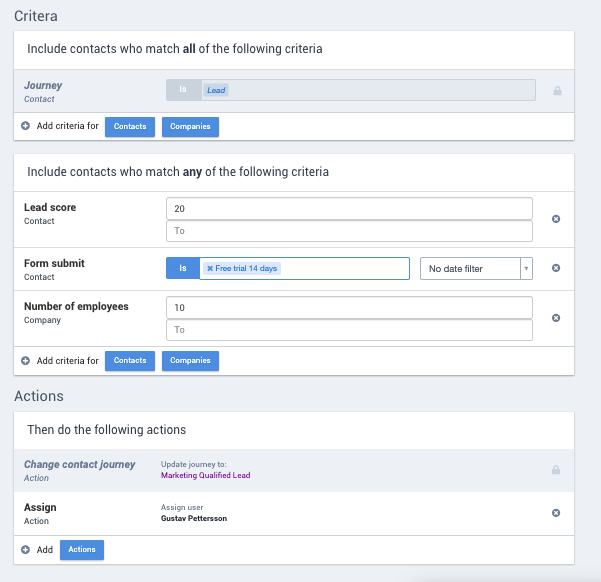
Customers told us they had huge databases of customers – but didn’t know where they were on the sales cycle. That’s why we’ve made it easier for you to find the opportunities within your data, whether for acquisitions, engagement, or retention.
Every sales person has phoned a “hot lead” only to discover the prospect has no interest in what they're selling.
This happens every day in sales departments across the world. In fact, it’s so common that it’s barely acknowledged as a problem. It’s just seen an irritating fact of life.
But this is a problem, not just for sales but for the business as a whole. When sales and marketing aren’t aligned then opportunities dry up. It’s only a matter of time before revenue dips.
Our new Journey feature was developed to address this issue. It’s a new way of tracking and scoring leads that work for marketing and sales. And it gives everyone fresh insight into why customers act the way they do.
A better view of the buyer journey
One of the most irritating things about chasing weak leads is that you rarely find out how they became MQLs in the first place. Marketing scores prospects and often keeps scoring criteria to themselves.
Sales rarely get insight into the buyer journey either. Valuable information on prospects – such as the products they’ve browsed, the content they’ve consumed, the events they’ve attended – is kept from you.
Lead Journey changes this dynamic. It gives both marketing and sales full access to the entire buyer journey. Both parties can see exactly how prospects moved from being intrigued, to engaged, to ready-to-buy.
This insight makes it much easier to match prospects to appropriate sales reps and can help you tailor or even fully-customize pitches. More importantly, it can help you decide if a lead really is a lead before dialing their number.
It’s also better for marketing. Marketers can see what happened to their leads post-handover – whether they ended up converting or if they were discarded. And this insight can help them hone their strategies and lead scoring system.

Lead scoring reimagined
Speaking of lead scoring, we’ve changed the way this works with Journey.
Both sales and marketing can now use what they know about prospects and customers to create custom criteria for scoring and automatically assign leads who match your criteria.
So rather than rating leads based on clicks and download numbers, you can score prospects based on specific actions or criteria. So if you know that people who download a datasheet are more likely to convert than people who download a top-of-funnel eBook, you can give this action more weight in the scoring system or directly qualify the lead and assign to sales. This makes it much easier to root out weak leads early on in the process and ensure only relevant prospects make it through to sales.

Bridging the divide
Journey was designed with a specific goal in mind – to give sales people greater visibility into lead tracking and scoring, and to cut time off from marketers' manual work to qualify and assign leads. But it also helps bring sales and marketing together.
One of the biggest issues that drive sales and marketing apart is a lack of communication. Data is hoarded, strategies aren’t shared and intentions aren’t explained.
This lack of transparency can lead to suspicion on both sides. Sales think marketing is trying to exaggerate their performance with weak leads. Marketing thinks sales is making excuses.
Journey helps to remove some of this confusion and ambiguity.
By revealing the reality of the situation – how leads have been qualified – everyone can make informed decisions based on a shared view.
This is better for both parties. More importantly, it’s better for the business as a whole.
Journey will soon be available in the Upsales Growth plan.
Eager to know what else we’re working on? Read our first leak that discussed upcoming releases and how we choose new features. Take a look here.